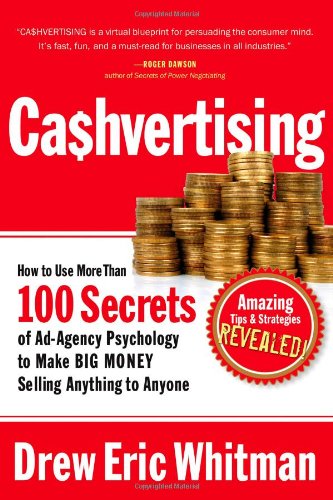Cashvertising Summary

5 min read ⌚
 How to Use More Than 100 Secrets of Ad-Agency Psychology to Make Big Money Selling Anything to Anyone
How to Use More Than 100 Secrets of Ad-Agency Psychology to Make Big Money Selling Anything to Anyone
Selling is a fundamental activity. Yet, so many people face bad results, because they do not know how to advertise their product properly.
To sell successfully, it is crucial to know people’s primary drivers and desires. That is exactly what this summary is about.
In the following overview of “Cashvertising,” we show you how to use human psychology to touch your customers’ “buttons” and motivate them to buy.
Who Should Read “Cashvertising”? and Why?
Selling is fundamental human interaction. However, most marketers know very little about the drivers that make people buy.
“Cashvertising” is a short but useful book in which Drew Eric Whitman uncovers the mysteries covering consumer behavior by providing insight into some basic psychological principles.
We recommend this book to all marketers since we believe that anyone will find “Cashvertising” useful for developing their advertising skills.
About Drew Eric Whitman
 Drew Eric Whitman has taught consumer behavior and response for more than two decades. He has worked as a consultant for many large companies.
Drew Eric Whitman has taught consumer behavior and response for more than two decades. He has worked as a consultant for many large companies.
“Cashvertising Summary”
Effective advertising does magic.
It motivates people to buy products or services that they may not even need.
However, most advertising experts forget this objective: making people spend money, and focus on being clever or win creative awards instead.
We understand that awards are great for your image, but they will not increase your sales.
If that is the case, then why so many marketers make the same mistake?
Well, because they just don’t know any better.
Here is the good news: You can learn specific techniques that will take you back to the right path towards influencing your customers’ actions.
Sellers need to understand human psychology since they have to use persuasion. They need to understand what people want, how they feel about what they want, and try to answer their needs.
All human beings have eight basic desires. Advertisements that connect to these desires generate a reaction in customers. Those desires are:
- To survive and to have a pleasant life.
- To enjoy food and beverages.
- To be free from “fear, pain, and danger.”
- To have “sexual companionship.”
- To live in a comfortable environment.
- To win and to keep pace with their neighbors.
- To care for and protect their loved ones.
- To gain social approval for their actions.
Of course, humans are complex and have more desires, but those are secondary like wishing to be clean, efficient, or wanting to cultivate their beauty and style.
However, these secondary, learned desires are not as powerful as the biological ones.
Below we list the key lessons, which will show you different strategies to make people buy, and the importance of how you pack it up in words.
Key Lessons from “Cashvertising”
1. Driving People To Buy
2. How You Say It Matters
3. Going Online
Driving People to Buy
To create effective advertisements, you first have to get to know their customers, their needs, and feelings. Once you get that insight, you can use it to gain a strategical advantage. We list the “Foundational Principles of Consumer Psychology” below
- “Mental movies.”
People feel pleasure when their desires are satisfied. However, they can feel the same pleasure by seeing others achieve the same satisfaction. This is the case because people can mentally project themselves into the life they desire. Hence create visual and detailed language in your ads, so your customers connect to the product you offer even before buying it.
- “The fear factor.”
Fear is yet another powerful motivator. Create stress by alerting your customers to possible danger, and then offer them a solution to relieve the tension.
- “Ego morphing.”
You can influence your clients’ behavior by making them see your product as a part of your identity, a technique called ego morphing. You can put this method into practice by using spokespeople that people will want to identify with.
- “Transfer”
Being credible is crucial in advertising. The transfer is a method that uses the authority of trusted institutions and people that promote your product, to increase consumer confidence in it.
- “The bandwagon effect.”
All people need a sense of belonging. As a result, they want to hang around people that share their values, or that offer them a particular status. Hence, you can sell your products by linking them to some groups that your customers associate with.
- “The means-end chain.”
When you create your ads, keep in mind that your customers will buy your product if it promises them future returns.
- “Persuasion step by step.”
The most significant challenge you will face is selling to someone who is unacquainted with your product or service. Note that people learn about new products in stages: ignorance, familiarity, willingness to buy. Only in the final stage do they become loyal clients. Create ads that match each step of the familiarity process.
- “Belief reranking.”
Changing people’s beliefs is difficult. So, take the easier route and work on reshuffling the importance of their existing views. In other words, try to strengthen the ideas that support them buying your product, and weakening those that don’t.
- “The Elaboration Likelihood Model”
According to this model, there are two ways to influence buyers’ attitudes. Ads that target people’s “central route processing” appeal directly to their reason and logic, whereas those that aim at their “peripheral route processing” persuade them to buy using pleasant images and other “cues.” People use central route processing when considering big purchases, such as a home, and peripheral route processing for small purchases, such as a grocery item. Over time, believes that consumers form through rational analysis are much more likely to stick.
- “Weapons of influence.”
There are a few ways to persuade people. You can activate their reflex to belong to peer groups. You can reinforce their impulse to reciprocate gifts, such as free samples. You can attract them to your authority. Alternatively, you can push them to buy by making something look scarce.
- “Evidence”
Your customers want to know the value they will get out of your product. Providing facts, testimonials, research or other types of evidence is a great way to convince them that your product is right for them.
How You Say It Matters
At the point when you have chosen your strategy, move to developing your message. In print ads, be brief, clear and straightforward. Express the most significant benefits in a few memorable words. Adopt a newspaper tone, since readers consider this style as more serious than that of a traditional advertisement. Use photographs and illustrations, and create a balance between graphics and text. Appeal to the all five senses.
Going Online
The Internet transforms advertising by adding new twists to it. If you e-mail your ads, note that your customers will most probably want to receive e-mails no more than once a week. Create dynamic e-mails by adding graphics and animations that draw attention. Do not confuse click-through rate with increased sales.
Like this summary? We’d Like to invite you to download our free 12 min app, for more amazing summaries and audiobooks.
“Cashvertising” Quotes
Loading your advertising with benefits is an essential element that leads to a successful advertising campaign. Share on X You don’t need to reinvent the lightbulb...just switch it on, it's that simple. Share on X The features are actually the real attributes. The benefits emerge as a result of those attributes. Share on X Your copy and images should always represent the positive outcomes, and neglect the others. Share on X Your primary objective wouldn't be to invent new fears, but to tap into existing ones. Share on XOur Critical Review
“Cashvertising” is a book filled with well-researched facts that will help you develop ads that touch your customers’ deepest desires. Whitman primarily focuses on print advertising so that some contemporary readers may wish for more information on Internet advertising.








